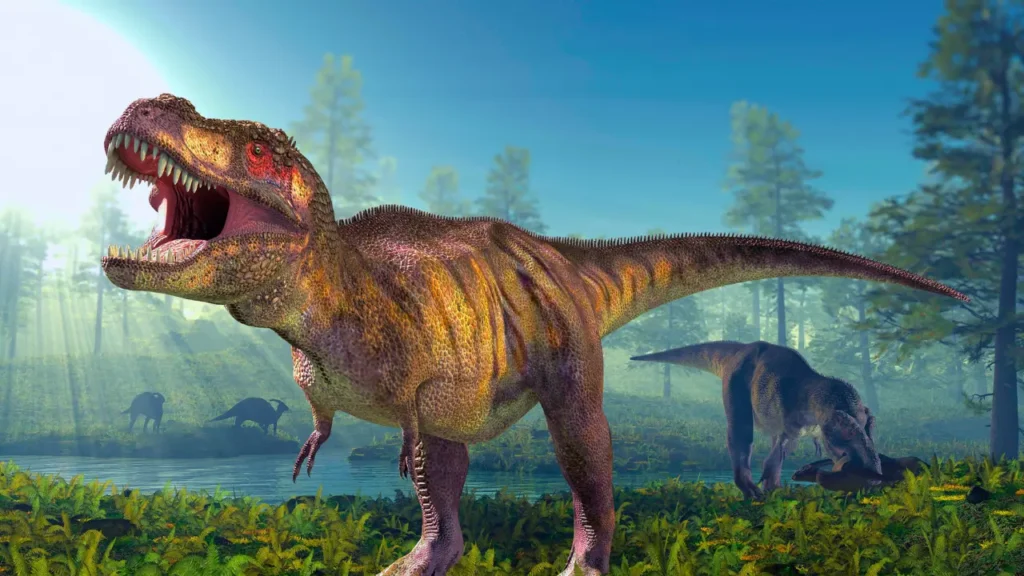
A groundbreaking discovery of Tyrannosaurus has emerged in paleontology: a dinosaur, previously known only from a partial skull, has now been officially recognized as a distinct species within the Tyrannosaurus genus. This finding introduces a fresh perspective to ongoing debates regarding potential relatives of the well-known Tyrannosaurus rex.
Unveiling Tyrannosaurus mcraensis
The fossil in question, originally discovered four decades ago, was carefully re-examined by Anthony Fiorillo and his team at the New Mexico Museum of Natural History and Science. Situated in the McRae Group rock layers in western New Mexico, the specimen was initially categorized as T. rex. However, closer inspection revealed significant differences in bone structure.
Fiorillo and his colleagues propose that the fossil represents a previously unidentified species, now named Tyrannosaurus mcraensis, paying homage to the geological formations where it was found. Estimated to be approximately 12 meters long, similar in size to T. rex, this newly identified species predates its more famous relative by around 4 million years.
Delicate Distinctions
Distinguishing features between T. rex and T. mcraeensis are described as subtle. While T. rex boasted prominent brow ridges and robust, bone-crushing jaws, T. mcraeensis exhibits less developed ridges and a more slender skull, according to Fiorillo.
Recent studies have floated the idea of multiple Tyrannosaurus species, challenging the classification of certain T. rex fossils. These propositions have been met with controversy and skepticism within the dinosaur paleontology community. The discovery of T. mcraeensis will likely intensify discussions about the number of Tyrannosaurus species that once roamed North America.
Jared Voris at the University of Calgary expresses reservations, stating that many features attributed to the new species are also present in T. rex specimens. Despite differing opinions on species classification, the presence of a sizable tyrannosaur predating T. rex suggests southwestern North America played a pivotal role in the evolution of these iconic predators.
Also Read : Why do flamingos stand on one leg?
Insights into Dinosaur Evolution
The newly identified tyrannosaur shares its geological context with other notable dinosaurs, including giant horned dinosaurs, duckbilled dinosaurs, and long-necked herbivores. Fiorillo and his team speculate that the lineage leading to T. rex may have evolved their massive size to prey on these large herbivores, later expanding northward as one of the last “tyrant lizards” to roam the Earth.
In conclusion, recognizing Tyrannosaurus mcraesis as a distinct species opens avenues for further research and fuels ongoing debates about the diverse tyrannosaur population in North America during the late Cretaceous Period. The peculiar age dates of the specimen also beckon for more extensive study, promising to contribute valuable insights into the last few million years of dinosaur evolution.
What is the new species of T. rex found?
The newly discovered species is not a T. rex but a distinct member of the Tyrannosaurus genus. Tyrannosaurus mcraensis is a significant finding that adds complexity to our understanding of the tyrannosaur family tree.
What is the name of the Tyrannosaurus fossil?
The fossil has been officially named Tyrannosaurus mcraensis. This nomenclature pays homage to the geological context where the specimen was unearthed – the McRae Group rock layers in western New Mexico.
What is the earliest Tyrannosaurus?
While Tyrannosaurus rex is the most iconic member of the tyrannosaur family, the newly identified Tyrannosaurus mcraensis predates T. rex by approximately 4 million years. This makes T. mcraeensis one of the earliest known tyrannosaurs, shedding light on the evolutionary timeline of these formidable predators.
What is the newly discovered Tyrannosaurus?
The newly discovered Tyrannosaurus is Tyrannosaurus mcraensis, a species identified from a partial skull fossil found 40 years ago. It shares similarities with T. rex but exhibits distinct features, such as less developed brow ridges and a more slender skull. Estimated to be around 12 meters long, this dinosaur provides valuable insights into the diversity and evolution of tyrannosaurs in North America during the late Cretaceous Period.